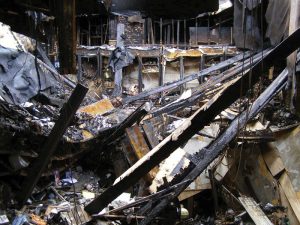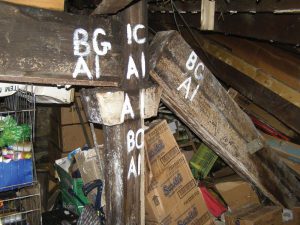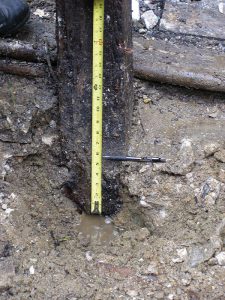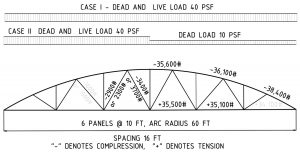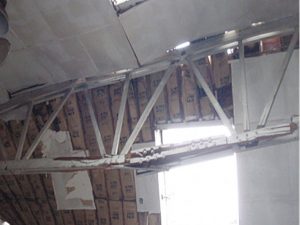The usual investigation of a fire incident consists of an effort to establish the origin and causes of the fire. More detailed investigations may be expanded to estimate the fuel quantity, the heat developed, and its duration. Building re-occupancy may take place only after a structural engineering assessment of the effect of the fire on the existing structural system.
Even in cases where a significant structural collapse occurred during the fire incident, the investigation remains focused on issues of evaluating potential arson, negligence, or fire code compliance. Typically, the fire is deemed the primary cause of the collapse and, as a result, the scope of the investigation remains limited to fire issues and does not include the totality of the incident.
Fire has a relatively limited effect on masonry and concrete structures but can dramatically change the capacity and stability of steel structures and can consume wood structures. Published cases of collapse incidents involving steel buildings have described an assessment of the condition of code prescribed fire protection of the steel. For several World Trade Center (WTC) buildings, structural engineers partnered with fire experts for the evaluation of how changes in the stability or capacity of steel members led to the structure’s collapse.
Collapses of Wood Floors or Roofs
For wood-framed buildings, because of the capacity of the fire to spread quickly and consume wood, a collapse is considered a likely outcome and structural engineers may not be called to participate in the evaluation of the incident.
Buildings with bearing masonry walls and wood floors resist fires somewhat better – combustible floors might collapse, but this collapse is not expected to engage the walls. Since the mid-1800s, successive New York City (NYC) building codes have required the ends of wood joists be “fire cut” to allow the burning floor to collapse without inducing torsional effects in the supporting masonry walls, thus preventing the walls’ collapse. Since fire investigators can establish the presence of “fire cuts,” structural engineers may not be called to join the investigation.
Structural engineers can bring valuable input as fire might not have been the only trigger of the collapse. For example, they can determine the building loads that existed at the location of the collapse. Even if the fire caused the collapse, the structural engineer’s participation can bring additional technical context and information, and lead to a more complete understanding of the incident.
There may be cases where the fire is the immediate cause of the incident but not the primary or essential cause of the collapse. One could argue that the National Fire Protection Association’s NFPA 921 – Guide for Fire and Explosion Investigations also should recommend expanding forensic investigations to include hypotheses beyond fire. An investigation in The Bronx illustrates such a case where the collaboration between fire and structural specialists led to the determination that the cause of the collapse was due to structural defects rather than fire.
Bronx Fire and Floor Collapse
The author was called to participate in the New York City Fire Department’s (FDNY) investigation of a fire incident that occurred at a “99 Cents” store in the Bronx. The fire completely destroyed the wood roof framing of this one-story plus basement structure (Figure 1). During the firefighting operations, the ground floor collapsed, taking the life of two firemen that were fighting in the basement. Several years prior, the store had suffered another roof fire. Subsequently, the roof had been rebuilt. The ground floor, including the supporting wood columns, were built as mill construction (slow-burning construction) using sturdy elements. Along the perimeter, the ground floor was supported by masonry bearing basement walls. Typical of mill construction, the center-heavy timber girders were supported by bolsters set on top of 8-inch by 8-inch timber posts. Almost all the roof joists burned and were lying on top of the collapsed first floor.
As the piece-by-piece removal and examination of the debris progressed, the probability of the fire causing the ground floor collapse decreased – the ground floor supporting structure only had a few joists that displayed charring. The areas of wood breakage were away from the char. One seriously considered hypothesis of causation was the load that existed on the floor – the store was full of merchandise with very narrow space between shelves. The original carrying capacity of the floor was 100 pounds per square foot (psf). All the debris content of the first floor was trucked away and weighed; merchandise and floor load amounted to about 70 psf. The debris field indicated that the collapse had occurred by means of the failure of connections of some timber girders to posts (Figure 2). There was evidence of prior and repeated tinkering with the support of the ground floor.
Ultimately, the cause of the collapse was deemed to be rot existing at the base of the timber columns (Figure 3). When erected, these posts had their bottoms extended about 12 inches into the ground where they rested on natural marble outcrops. Over the years, the rot had led to a slowly progressing settlement of the center columns (the perimeter masonry bearing brick walls had not settled). The center columns had lost much of their bearing function. As the settlement had progressed slowly, the owner was able to use shims, wood cribbing, and other types of shoring to mitigate the settlement’s effect. These “fixes” did not include the repair of broken beam-to-post connections. During the fire, the sudden additional load of water (from fire hoses) and firefighting personnel led to the abrupt settlement of one of the supporting columns. The conclusion was that the floor failure was due to the disturbance imposed on the system by the large, sudden movement caused by the abrupt shortening of the column. Only the collaboration between fire and structural engineering professionals made possible the determination that the fire was the event that started a chain, but the underlying cause of the collapse was the presence of significant rot at the base of the column.
One should note that, by the time this store was erected (1928), there were numerous publications and handbooks warning about the dangers of embedding wood columns (posts) in soil. As a result, the established practice (which was not adhered to in this case) was to set the bottom of wood posts on pedestals raised 6 inches above the finished floor.
Wood Bowstring Roof Trusses
The 1984 collapse of the roof of a Waldbaum’s store and the resulting death of seven firefighters is deeply embedded in the lore of the FDNY. The roof framing consisted of a system of wood bowstring trusses. Bowstring trusses consist of an arched top chord (the bow) joined at each end by a straight bottom chord (the string). From a structural engineering perspective, bowstring trusses differ from other types of trusses in that the bottom chord essentially has the same tension force over its entire length. One available analysis of this collapse describes it in terms of the difficulty of fighting fires in tall attic spaces. This fatal event is mentioned as a warning in many books dedicated to firefighting. The primary recommendation is the use of defensive strategies for fighting fires in buildings with roofs supported by wood bowstring trusses. The typical firefighter’s concerns with wood trusses include the high probability that the failure of one single element might lead to the collapse of an entire frame.
In 1988, five firefighters lost their lives during a fire as a result of the collapse of a bowstring truss roof in Hackensack, NJ. A fire investigator observed that the collapse might have been structural, as the section of wood breakage did not show char.
Between 1930 and 1960, in many areas of the country, wood bowstring roof trusses were a common solution for hangars, warehouses, and movie houses. They were sold and marketed via catalogs and manufactured by approved fabricators. Due to the lack of a national system for reporting and issuing advisories about structural failures, we lack a clear count of how many bowstring collapses have occurred. Fatalities of volunteer and professional firefighters are counted by the National Institute for Occupational Safety and Health (NIOSH). Including the Waldbaum’s incident, there have been at least 15 firefighter fatalities in fires of wood bowstring truss roofs.
Engineering of Wood Bowstring Trusses
By 1996, the paper, “Investigating and Repairing Wood Bowstring Trusses” by Kristie and Johnson in the Practice Periodical for Structural Design and Construction was drawing attention to the structural design deficiencies of wood bowstring trusses. Kristie and Johnson indicated that, due to heavy snows in 1979, there had been a good number of collapses in the Chicago area. These authors found that the main deficiency was an overestimation of the wood tensile capacity in the first half of the 20th century when the allowable tensile stress was considered equal to the tensile stress in bending. Depending on the type of wood, this overestimation might have reached 60%. Additionally, the older design practice overestimated the capacity of bolted splice connections by close to 30%. Around 2008, several local chapters of Structural Engineers Associations (Texas, Washington) re-published an article by Gilham and McKee of Western Wood Structures that described how bowstring trusses failed to meet present day (2008) codes. The report notes that, under heavy snows, there are breaks in truss elements but “the breaks seldom lead to a total roof collapse.”
A review of a drawing of the Bowstring Roof Truss in the 1944 Timber Engineering Company’s (TECO) Typical Design reference manual reveals, with some approximation, the level of noncompliance to the NYC code. TECO analyzed two loading combinations (Figure 4): (a) a total 40 psf dead and live load over the entire span, and (b) a 40 psf dead and live load for one half of the span and a 10 psf dead load for the balance of the span. As expected, the entire length of the bottom truss chord had to be designed for the same tension force. The TECO notes refer only to a minimum 1200 pounds per square inch (psi) extreme fiber bending stress. As an example, if the bottom truss chord used allowable stresses, say 50% of what we accept today, it would mean that, per code, the truss could carry a total load of about 20 psf. After subtracting the dead load, the remaining 10 psf represent the weight of about 5 to 6 inches of wet snow. The fact that many trusses still stand might be explained by the high factor of safety used for wood strength; since the 1920s, the factor of safety for wood has varied somewhere between 6 and 4, mainly because of the large variability in the strength of natural materials.
Inspection Program
Engineers at the NYC Buildings Department (DOB) became aware of the structural design flaws in 2013 when the FDNY Safety Chief flagged a series of articles, including the NIOSH Report F2012-08, Volunteer Lieutenant Killed and Two Fire Fighters Injured Following Bowstring Roof Collapse at Theatre Fire – Wisconsin, (November 11, 2012). The report detailed a wood bowstring truss fire that had resulted in one firefighter fatality and two injuries. The Report mentioned that “Bowstring truss roof systems may suffer from a little-known phenomenon related to inaccuracies in early industry-accepted truss design.” A review of NYC accident records revealed two prior cases of bowstring truss roof collapses. Both incidents had occurred in vacant buildings and did not involve injuries (Figures 5 and 6).
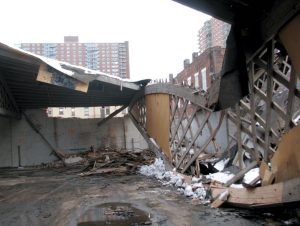
Figure 5. Collapsed “Belfast” bowstring truss. Wood failed at bottom chord mid-span. Note relatively small snow cover.
The engineering reports observed that the roofs were covered with several inches of snow. One of the collapsed bowstring trusses was of the “Belfast“ type (which used a lattice system for webbing) and might have been produced by several different manufacturers (Figure 5). One should note that, in many instances, design errors are latent; that is, they are not evident in the absence of an analysis of the original design and additional material testing.
After receiving the FDNY information, a number of facilities with wood bowstring truss roofs were inspected to form an opinion on their condition. In several cases, it was discovered that the trusses had pushed the supporting masonry piers outward – a clear sign of weakening or excessive relaxation of the bottom chords under tension. Other deficiencies noted were related to wet conditions; decay was most common, especially at the areas of the truss end where water could have penetrated through the walls or leaks around the parapet flashing.
An additional incident involving a bowstring truss collapse under snow load occurred while the FDNY and DOB exploratory investigation was underway. Consequently, all owners of buildings with bowstring roofs were ordered to engage a structural engineering consultant to perform condition assessments and structural analyses. The department also issued a bulletin clarifying what editions of national standards were permitted to be used for the assessment of wood members. They identified close to 150 existing buildings with bowstring roof trusses. Only about 10% of the buildings had trusses that did not require repairs. The DOB’s collaboration with the FDNY led to repairs and an increase in safety for occupants, and also identified the structures where firefighting would need to use special tactics.
Black’s Law Dictionary defines a defect as an imperfection or shortcoming, especially in a part that is essential to the operation or safety of a product. Before the 1960s, the testing procedure for the tensile capacity of wood members was inaccurate and led to a design defect that caused several collapses under snow loads. One can infer that this defect might have also been a contributing factor to the collapse of wood bowstring trusses in fire conditions. For instance, the F2012 NIOSH report notes an incident where the roof was covered with snow. A picture in the report displays about the same snow cover as in Figure 5. A new tile ceiling had been installed, hanging from the truss and covering the old ceiling. From the description, one can assume that the roof might not have been very far from its design capacity. In these conditions, a relatively small disturbance of the structural system might have led to a loss of stability.
Summary
It seems, in the aftermath, there was no specific structural analysis nor report regarding wood bowstring trusses that had collapsed in fire conditions. As a result, no consideration was given to hypothesize that the collapses had a structural cause. One can only wonder if, in some of the incidents, that might have been the case. Even if there had been no direct correlation between the collapse in fire and the structural capacity, the original design defects compromised the bowstring truss system’s structural reliability and, therefore, reduced the time available for firefighting from inside such burning buildings.
This article illustrates the benefits that can be brought about by the participation of structural engineers in fire investigations to determine a structural root cause of a collapse (The Bronx case) or to place in evidence structural contributory factors to a collapse (bowstring trusses). Structural engineers can help identify and differentiate classes of buildings that require special firefighting tactics (e.g., wood bowstring trusses vs. other truss types). The collaboration of fire and structural specialists also requires that structural engineers gain a better understanding of firefighting operations and the effect of fire on specific building assemblies.
For their work on bowstring trusses, the DOB forensic team (Jill Hrubecky, Timothy Lynch, and Yegal Shamash), in collaboration with Simon Ressner of FDNY, received an SEAoNY Special Award For Outstanding Contribution to Public Safety.▪

